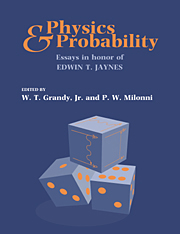Book contents
- Frontmatter
- Contents
- Preface
- Recollections of an Independent Thinker
- A Look Back: Early Applications of Maximum Entropy Estimation to Quantum Statistical Mechanics
- The Jaynes–Cummings Revival
- The Jaynes–Cummings Model and the One-Atom-Maser
- The Jaynes–Cummings Model is Alive and Well
- Self-Consistent Radiation Reaction in Quantum Optics – Jaynes' Influence and a New Example in Cavity QED
- Enhancing the Index of Refraction in a Nonabsorbing Medium: Phaseonium Versus a Mixture of Two-Level Atoms
- Ed Jaynes' Steak Dinner Problem II
- Source Theory of Vacuum Field Effects
- The Natural Line Shape
- An Operational Approach to Schrödinger's Cat
- The Classical Limit of an Atom
- Mutual Radiation Reaction in Spontaneous Emission
- A Model of Neutron Star Dynamics
- The Kinematic Origin of Complex Wave Functions
- On Radar Target Identification
- On the Difference in Means
- Bayesian Analysis, Model Selection and Prediction
- Bayesian Numerical Analysis
- Quantum Statistical Inference
- Application of the Maximum Entropy Principle to Nonlinear Systems Far from Equilibrium
- Nonequilibrium Statistical Mechanics
- A Backward Look to the Future
- Appendix: Vita and Bibliography of Edwin T. Jaynes
- Index
On Radar Target Identification
Published online by Cambridge University Press: 21 October 2009
- Frontmatter
- Contents
- Preface
- Recollections of an Independent Thinker
- A Look Back: Early Applications of Maximum Entropy Estimation to Quantum Statistical Mechanics
- The Jaynes–Cummings Revival
- The Jaynes–Cummings Model and the One-Atom-Maser
- The Jaynes–Cummings Model is Alive and Well
- Self-Consistent Radiation Reaction in Quantum Optics – Jaynes' Influence and a New Example in Cavity QED
- Enhancing the Index of Refraction in a Nonabsorbing Medium: Phaseonium Versus a Mixture of Two-Level Atoms
- Ed Jaynes' Steak Dinner Problem II
- Source Theory of Vacuum Field Effects
- The Natural Line Shape
- An Operational Approach to Schrödinger's Cat
- The Classical Limit of an Atom
- Mutual Radiation Reaction in Spontaneous Emission
- A Model of Neutron Star Dynamics
- The Kinematic Origin of Complex Wave Functions
- On Radar Target Identification
- On the Difference in Means
- Bayesian Analysis, Model Selection and Prediction
- Bayesian Numerical Analysis
- Quantum Statistical Inference
- Application of the Maximum Entropy Principle to Nonlinear Systems Far from Equilibrium
- Nonequilibrium Statistical Mechanics
- A Backward Look to the Future
- Appendix: Vita and Bibliography of Edwin T. Jaynes
- Index
Summary
Introduction
Humans have long been interested in devices which extend their senses, the telescope being an early example of such a device. We have since progressed to systems which operate in domains beyond the normal senses, as in the use of x-rays in medical imaging or seismic waves to probe the earth. Nevertheless, most existing remote sensing systems operate with considerable human input and interpretation; naturally, there is great interest in developing remote sensing systems which can with greater autonomy identify or recognize salient aspects of their environments. Potential applications of such systems abound:
Air-traffic control (identification of incoming aircraft).
Air defense (recognizing friendly or hostile aircraft).
Quality assurance (assembly line inspection).
Medical screening (identifying anomalies in radiographic or tomographic images).
Security and surveillance systems.
Robotics (navigation, carrying out tasks).
Exploration geophysics (interpreting seismic data).
Analytical chemistry (neutron activation analysis, nuclear magnetic resonance, other kinds of spectroscopy).
Detection of unexploded subsurface munitions.
All of these systems have in common the detection and processing of signals. In some cases (e.g., radar), the system must also emit a signal which interacts with the environment and is subsequently detected in modified form.
Though our understanding of human perception and information processing is incomplete, the very fact that recognition and identification are biologically possible demonstrates that the problem is not fundamentally intractable.
- Type
- Chapter
- Information
- Physics and ProbabilityEssays in Honor of Edwin T. Jaynes, pp. 161 - 176Publisher: Cambridge University PressPrint publication year: 1993
- 3
- Cited by

